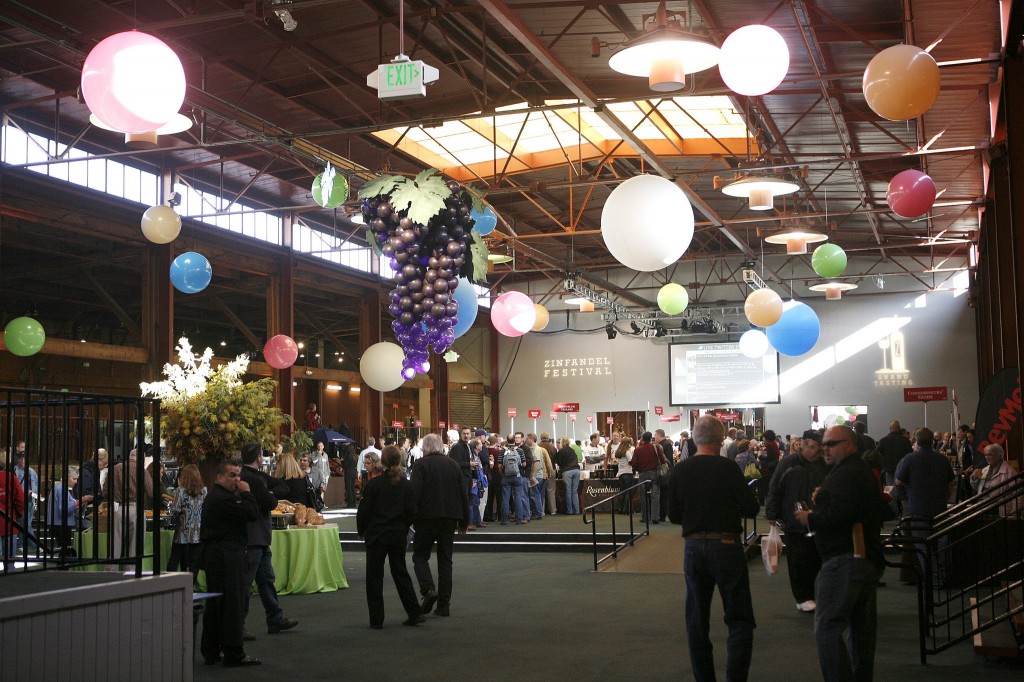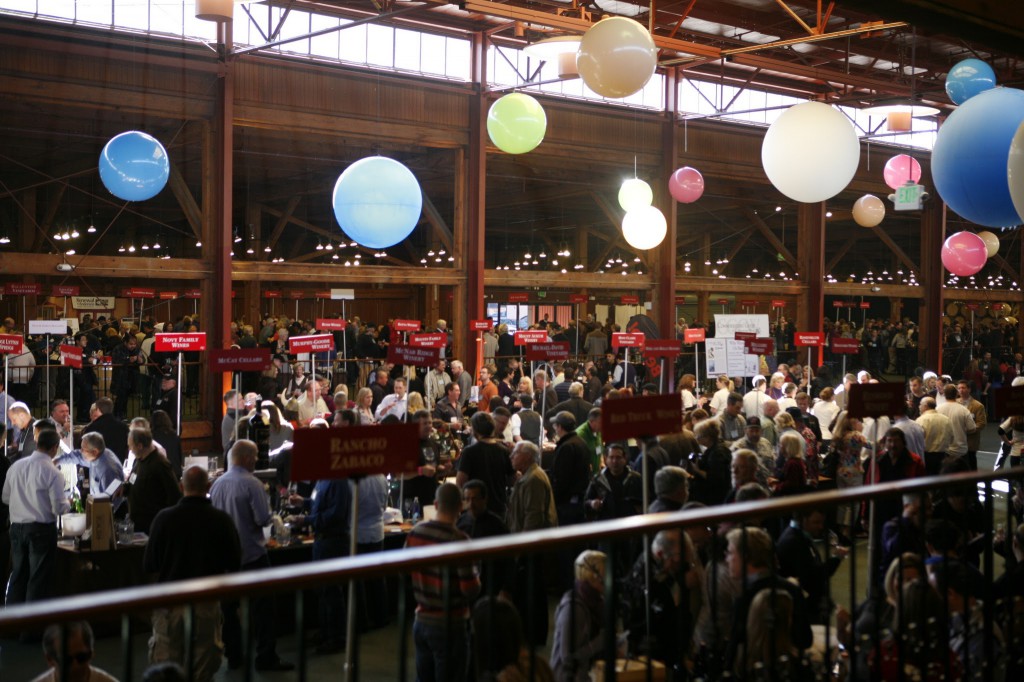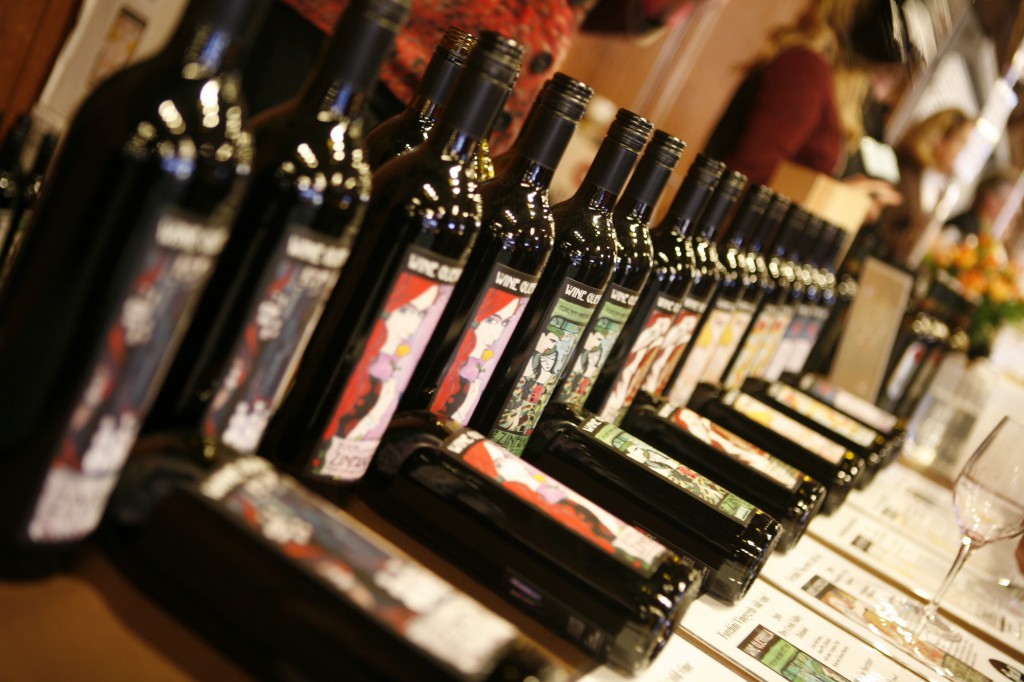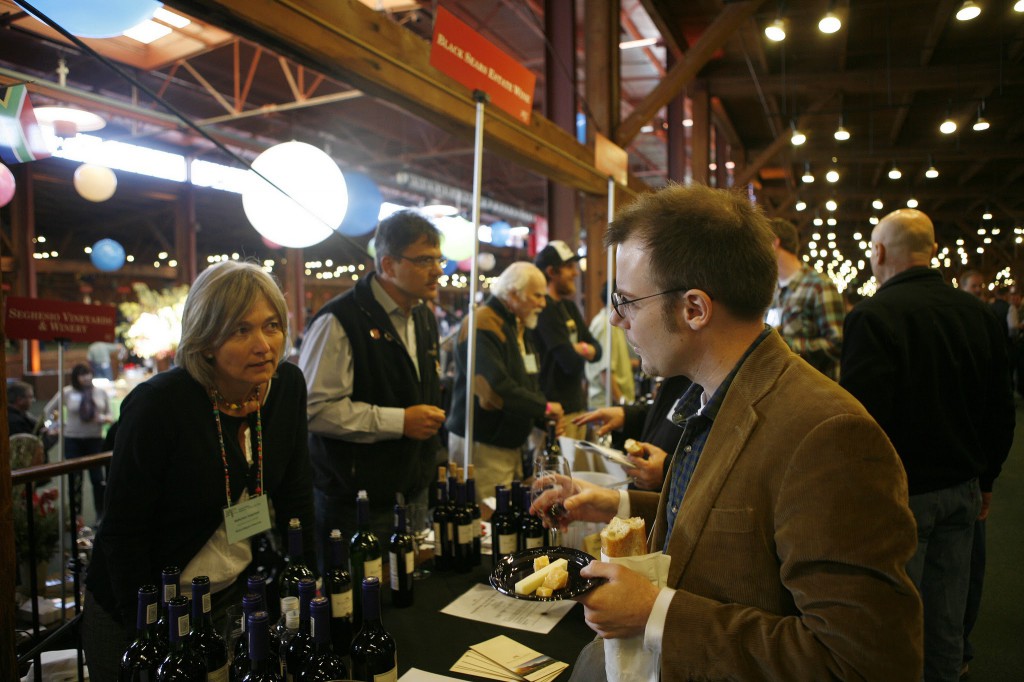BY NATHAN CRANFORD
Over the weekend I had the privilege to get a taste (pun intended) of what it would be like to do exactly what I’ve always wanted to do for a living: attend food and wine tasting festivals as a member of the press–and luckily for me, there would be no better place for me to experience this for the first time than at San Francisco’s 21st Annual Zinfandel Festival.
It was a beautiful Saturday morning on January 28th, and the Zinfandel Festival was ending its four day line-up of events with its traditional Grand Tasting. Looking forward to imbibing (within reason) at 10:30AM that morning, together with my trusty photographer, we made the trek from the East Bay, across the bridge and into San Francisco where the festival was taking place.
Once we made it to the The Concourse building, located South of Market, I was surprised how many other individuals and groups were lined up at the gates. Suddenly I felt decidedly less special–as the sheer number of people from trade groups and the media led me to believe that general admission was occurring several hours earlier than planned. It wasn’t until I was able to park and gain entry to The Concourse that I was able to comprehend the tremendous scope of the Zinfandel Festival. I immediately realized that this wasn’t going to be like the many plotted out and contained wine tasting experiences I’ve had in the past.
Having never been to The Concourse before, I was somewhat unaware of how large the venue is. Booths managed by winemakers stretched as far as the eye could see. Situated at various spots throughout the building were complimentary tables of breads, cheeses, fruit and other foods that are traditionally best eaten with a glass of wine–of the Zinfandel variety, of course. After gaining our press passes from the Festival’s lovely press liaison, Julie Ann, we were immediately offered a complementary baguette to pad our grumbling stomachs–all in preparation for a journey into what would prove to be a veritable treasure house of wines from all over the world being showcased for our tasting enjoyment.
Unfortunately, it was nearly impossible to decide where to start–there were just so many possibilities–a conundrum, I’m sure, that many wine lovers would love to have the opportunity to solve. Determined not to stick to wines that I’ve tasted in the past, we walked up and down The Concourse, looking from left to right at the signs demarcating the various booths, searching for a name that would just “jump out” at us. Soon enough, we stumbled upon a sign with the strangely alluring name “Old Moon,” manned, if you will, by two beautiful young women who were more than happy to walk us through our first wine tasting experience of the morning.
Old Moon is a winery based in Manteca–one of the fastest growing wine making locales in California–and makes wine specifically for those of us (myself included) with only enough economic “buying power” to frequent the two-buck-chuck aisle at Trader Joe’s. As a matter of fact, Old Moon makes their wine specifically for Trader Joe’s stores, sold for a mere $4.99. For the price, I was extremely surprised by the complexity of this particular Zin. Although, I must say that the wine’s overall fruitiness didn’t impress me, Old Moon’s Zinfandel is definitely a wine that can be enjoyed by those of us who still find themselves shopping on a very limited budget.
The next winemaker we came across also had a name and label that sort of stood out from the rest: Wine Guerrilla. As we waited in line for the tasting, I found myself mesmerized by the winery’s beautiful labels, which were pastel illustrations done in the style of Pablo Picasso. This proved to me that, in addition to being a valuable marketing tool, the label could artistically compliment the wine itself, as was the case with Wine Guerrilla. I had the opportunity to taste two of their delicious wines, both made from the 2009 grape yields of the Forchini Vineyard and the Coffaro Vineyard respectively. While I felt the Forchini selection was a near-perfect Zinfandel, I was particularly impressed by their Coffaro wine, which included a small percentage of Syrah grapes in the mix. The mix was done well enough so that the overall essence of the wine was suitably dominated by the Zinfandel, with the warm peppery savoriness of Syrah lingering in the background. Truly an impressive selection.
Interestingly enough, almost directly across the way from where we were standing was a winemaker that one could assume to be a suitable nemesis to Wine Guerrilla, if only thematically so. The Federalist, in addition to being an excellent wine, does indeed have a fascinating concept behind it. The winery’s representative gave an eye-opening account of the United States’ history with the famous Zinfandel grape–a history that stretches back to the American Colonial era. Zinfandel was one of the first grapes to be actively grown and cultivated by American farmers, and was one of the agricultural commodities actively promoted by our nation’s first Treasury Secretary Alexander Hamilton, whose visage can be seen on The Federalist’s Zinfandel label. Across the table from the winery’s main zin was a 50/50 Zinfandel/Syrah mix suitably named “Dueling Pistols” after the infamous duel between Hamilton and Vice President Aaron Burr that ended up taking the life of the former in 1804. However, unlike the actual duel, neither the Zinfandel nor the Syrah overpowers the other, and once more proved to me that the two grapes tend to compliment each other perfectly.
My final stop in what had been a pleasantly overwhelming wine tasting experience (and a nice baguette does indeed do wonders for keeping the tipsiness away) was a relatively nondescript booth hosted by two very kind and motivated winemakers from the South African winery Blaaunklippen, showcasing their own unique Zinfandel wines from the famed Stellenbosch wine region of the country. Having never had the opportunity to taste wine from the region, I was particularly intrigued how a completely different world setting could have an effect on the taste of the wine. I had the pleasure of tasting two wines, the first of which was their regular Zinfandel selection. The wine itself was delicious, and perfectly complimented the cheese I had been eating prior. However, by that time, my ability to taste the subtleties of the Zinfandel grape and its many oenological variations was at a low point. It wasn’t until I tasted Blaaunklippen’s Late Noble Harvest selection–a very tasty dessert wine that utilizes the Zinfandel grape that has ripened to the point of succumbing to what’s known as “Noble rot”–that my taste buds were perked up by its subtly complex sweetness, which reminded me of an interesting mix of Riesling and Port, if such a thing is possible.
To be honest, I could have spent the whole day (and night…) tasting each of the offerings being showcased at the 21st Annual Zinfandel Festival, but I was able to overcome the temptation and take the initiative to bid a fond farewell to my first, but most certainly not my last experience covering a major wine festival. Although I am very much aware that what I’ve written today only touches upon a very small fraction of what the Festival had to offer, I do feel that the winemakers highlighted here were definitely my personal favorites. The Zinfandel Festival as a whole, in addition to being a prized tradition of the City by the Bay, was perhaps the most comprehensive wine tasting experience I’ve ever had. If you’re a wine connoisseur, seller, or journalist you already know this, but for everyone else, the Annual ZAP Zinfandel Festival is surely an event that is not to be missed.
(Photos courtesy of Yoobin Han)
RELATED LINKS
Zinfandel Advocates & Producers (ZAP) Official Website
Follow us on Twitter and like us on Facebook to give us a shout. You can also stay on top of exciting events from around the world by downloading the eventseeker app for iPhone, Android or Windows.





